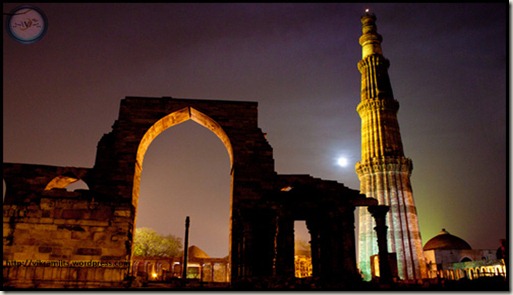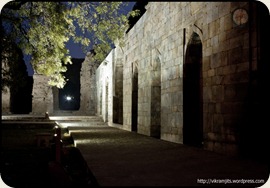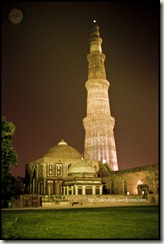Mamluk Sultan Altamash (Iltutmish) built the Minarah, which till date is the tallest rubble masonry minaret on earth. Then why do we call it the Qutub Minar?

The Qutb Minar (also spelled as Qutub Minar or Kutb Minar) is world’s tallest rubble masonry minaret and a world heritage site in Delhi. It is situated within the Qutb Complex, which has been the centre of the first city of Delhi since the first Muslim ruler stepped here. Before Muhammad-bin-Sam (Muhammad Ghori) defeated Prithvi Raj Chauhan, this land was with Tomar Rajpoots & Chauhans (Arkpal Tomar gave it to his grandson Prithvi). Chauhan extended the walls of Lal Kot to create Qila Rai Pithora. Ghori left his governor Qutb-ud-din Aibak to rule India after defeating Prithvi Raj Chauhan in 1060 A.D. and thus the slave dynasty started in India. There is a huge minar in the heart of this city, which most people attribute to this first Islamic ruler of north India – Qutb-ud-Din Aibak. But is this true? This article unfolds a story, least discussed in History.
The Qutb Complex was originally a site with 27 Hindu and Jain Temples. These temples were destroyed by the Islamic invaders to obtain stone and raw material for their mosques and other buildings. These temples existed much before Ghori was even born.
As the rulers from slave dynasty planned their buildings, they were short of raw material. By demolishing the majestic temples, they served another very important purpose. To ensure stronghold, it was important that the backbone of religion prevailing in conquered land is crushed. Destroying temples meant that the new Islamic Invaders had no respect for the religion being practiced by locals. They were in such hurry of completing the job, that they were not able to deface the statues properly. Even today, the remains of temples can be seen within the Qutb Complex
The First Jama Masjid
 For those who don’t know, ‘Jama Masjid’ (or Jami Masjid or Jumma Masjid or Masjid-e-Jami) is the majestic Friday Mosque built for the Muslim population of the city. Inscriptions on the Qutb Minar suggested that Qutb-ud-Din Aibak built this Mosque as the first building after stepping on Indian Land. This was the oldest mosque of North India. There are few mosques built in Tamil Nadu and Kerala before this. Qutb-ud-din Aibak was ruling over Delhi from 1206 to 1210 AD. There is a confusion over the actual name of this mosque. These days, we call it Quwwat-ul-Islam (Might of Islam) but the old books suggest that its name was Qubbat-e-Islam. R.N.Munshi even writes it as ‘Qutb-ul-Islam’. Further, Munshi quotes the translation of the inscription written on the walls of Mosque (done by Thomas in his book – Pathan Kings):
For those who don’t know, ‘Jama Masjid’ (or Jami Masjid or Jumma Masjid or Masjid-e-Jami) is the majestic Friday Mosque built for the Muslim population of the city. Inscriptions on the Qutb Minar suggested that Qutb-ud-Din Aibak built this Mosque as the first building after stepping on Indian Land. This was the oldest mosque of North India. There are few mosques built in Tamil Nadu and Kerala before this. Qutb-ud-din Aibak was ruling over Delhi from 1206 to 1210 AD. There is a confusion over the actual name of this mosque. These days, we call it Quwwat-ul-Islam (Might of Islam) but the old books suggest that its name was Qubbat-e-Islam. R.N.Munshi even writes it as ‘Qutb-ul-Islam’. Further, Munshi quotes the translation of the inscription written on the walls of Mosque (done by Thomas in his book – Pathan Kings):Kutb-ud-Din Aibak, on whom be the mercy of God, constructed this mosque.This fortress was conquered and this Masjid Jami was built during the months of the year 587 by the great and mighty commander-in-chief Kutb-ul-Dawlat-wa-ul-Din, the commander of commanders, Aibeg Sultan. May God exalt his helpers. Materials from 27 idol temples, each of which cost twice thousand into thousand Diliwals, have been used in this Masjid. May Almighty God send mercy on him, who prays for the rest of the builder.
Quote Ref: The History of the Kutb Minar (Delhi) by R. N. Munshi (1911)
Later this mosque was extended by Alaudin Khilji and a college (Madrasa) was added to it. When Khilji died, he was buried in the same mosque and his tomb, though not decorated with glorifying marble and inscriptions, was built in same complex.
Origin of Qutb Minar
 According to the popular belief, the Qutb Minar (or Qutub Minar) was built by the first Islamic ruler of North India, Qutubud-din Aibak. However, I have found numerous proofs that he neither had funds, nor time (in his tiny 4 year regime), to build, or even commence such a majestic structure. It appears to me that associating it with Sultan Qutb-ud-din Aibak was a “historian’s mistake”. If you read historians & travellers, who came to India during the Sultanate period, you will find that they honour this Minar as ‘Sultan Altamash’s Minar’. Hasan Nizami dedicated his work Taj-ul-Maasir (the crown of exploits) to sultan Aibak but also mentioned major events from the period of his predecessor and successor. There is no reference to any such Minar in this important piece of work, which talks about period after 7 years of death of Aibak. If Qutubuddin Aibak even dreamed about (if not commissioned) this minar, then we must have found atleast some mention in this book. But Hasan Nizami do talk about the Jami Masjid of Delhi built by Aibak in following manner:
According to the popular belief, the Qutb Minar (or Qutub Minar) was built by the first Islamic ruler of North India, Qutubud-din Aibak. However, I have found numerous proofs that he neither had funds, nor time (in his tiny 4 year regime), to build, or even commence such a majestic structure. It appears to me that associating it with Sultan Qutb-ud-din Aibak was a “historian’s mistake”. If you read historians & travellers, who came to India during the Sultanate period, you will find that they honour this Minar as ‘Sultan Altamash’s Minar’. Hasan Nizami dedicated his work Taj-ul-Maasir (the crown of exploits) to sultan Aibak but also mentioned major events from the period of his predecessor and successor. There is no reference to any such Minar in this important piece of work, which talks about period after 7 years of death of Aibak. If Qutubuddin Aibak even dreamed about (if not commissioned) this minar, then we must have found atleast some mention in this book. But Hasan Nizami do talk about the Jami Masjid of Delhi built by Aibak in following manner:
No comments:
Post a Comment